Effectiveness of International Environmental Guidelines and Standards
VerifiedAdded on 2022/10/04
|8
|2180
|36
Report
AI Summary
This report critically evaluates the effectiveness of International Environmental Guidelines and Standards in mitigating environmental impacts across various production sectors. The study begins by highlighting the concerns surrounding Environmental Management Systems (EMS) and the impact of production processes on the environment, emphasizing the role of Life-cycle Assessment and the adoption of ISO standards. The research hypothesis posits that these guidelines and standards effectively reduce environmental impact. The discussion analyzes sectors like food production, oil industries, and renewable energy, noting the limitations of current EMS practices, particularly the economic factors influencing adoption, the lack of governmental support, and the need for technological and economic viability. The report underscores the importance of governmental and institutional pressure, competitor influence, and corporate social responsibility in driving the adoption of environmental standards. It concludes by emphasizing the necessity of EMS, the impact of governmental initiatives, and the importance of collaboration between international bodies and producers to achieve environmental equilibrium.
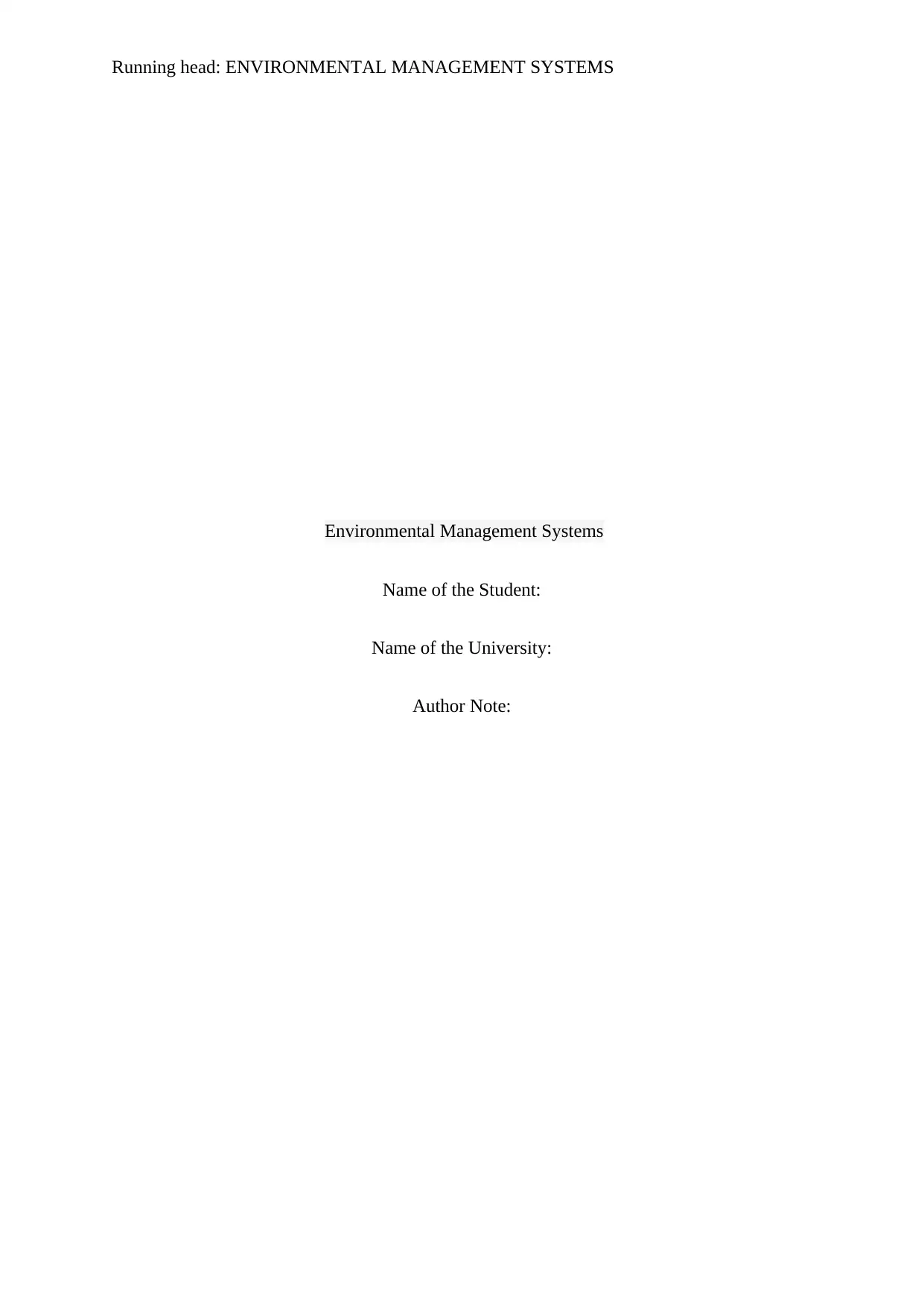
Running head: ENVIRONMENTAL MANAGEMENT SYSTEMS
Environmental Management Systems
Name of the Student:
Name of the University:
Author Note:
Environmental Management Systems
Name of the Student:
Name of the University:
Author Note:
Paraphrase This Document
Need a fresh take? Get an instant paraphrase of this document with our AI Paraphraser
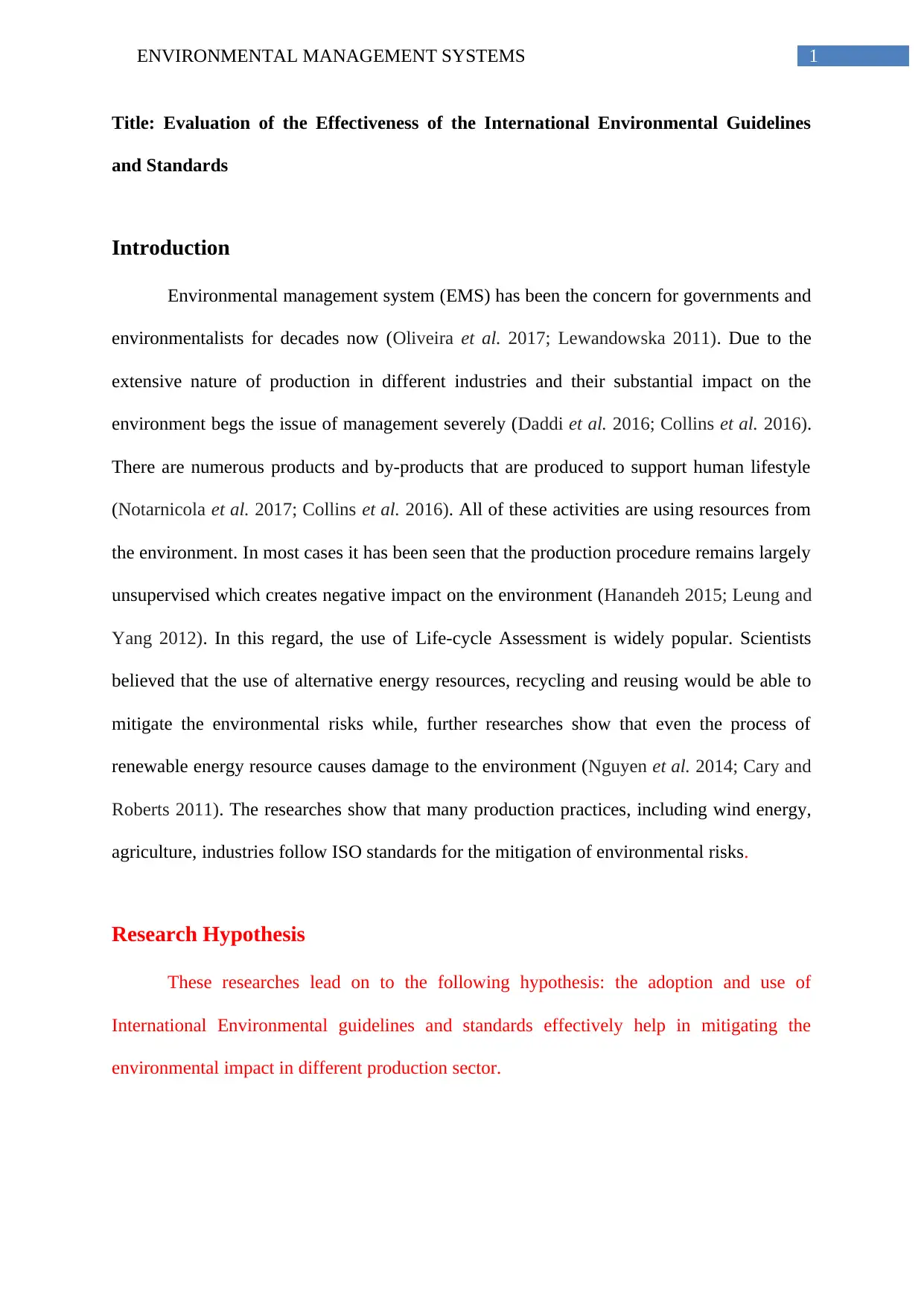
1ENVIRONMENTAL MANAGEMENT SYSTEMS
Title: Evaluation of the Effectiveness of the International Environmental Guidelines
and Standards
Introduction
Environmental management system (EMS) has been the concern for governments and
environmentalists for decades now (Oliveira et al. 2017; Lewandowska 2011). Due to the
extensive nature of production in different industries and their substantial impact on the
environment begs the issue of management severely (Daddi et al. 2016; Collins et al. 2016).
There are numerous products and by-products that are produced to support human lifestyle
(Notarnicola et al. 2017; Collins et al. 2016). All of these activities are using resources from
the environment. In most cases it has been seen that the production procedure remains largely
unsupervised which creates negative impact on the environment (Hanandeh 2015; Leung and
Yang 2012). In this regard, the use of Life-cycle Assessment is widely popular. Scientists
believed that the use of alternative energy resources, recycling and reusing would be able to
mitigate the environmental risks while, further researches show that even the process of
renewable energy resource causes damage to the environment (Nguyen et al. 2014; Cary and
Roberts 2011). The researches show that many production practices, including wind energy,
agriculture, industries follow ISO standards for the mitigation of environmental risks.
Research Hypothesis
These researches lead on to the following hypothesis: the adoption and use of
International Environmental guidelines and standards effectively help in mitigating the
environmental impact in different production sector.
Title: Evaluation of the Effectiveness of the International Environmental Guidelines
and Standards
Introduction
Environmental management system (EMS) has been the concern for governments and
environmentalists for decades now (Oliveira et al. 2017; Lewandowska 2011). Due to the
extensive nature of production in different industries and their substantial impact on the
environment begs the issue of management severely (Daddi et al. 2016; Collins et al. 2016).
There are numerous products and by-products that are produced to support human lifestyle
(Notarnicola et al. 2017; Collins et al. 2016). All of these activities are using resources from
the environment. In most cases it has been seen that the production procedure remains largely
unsupervised which creates negative impact on the environment (Hanandeh 2015; Leung and
Yang 2012). In this regard, the use of Life-cycle Assessment is widely popular. Scientists
believed that the use of alternative energy resources, recycling and reusing would be able to
mitigate the environmental risks while, further researches show that even the process of
renewable energy resource causes damage to the environment (Nguyen et al. 2014; Cary and
Roberts 2011). The researches show that many production practices, including wind energy,
agriculture, industries follow ISO standards for the mitigation of environmental risks.
Research Hypothesis
These researches lead on to the following hypothesis: the adoption and use of
International Environmental guidelines and standards effectively help in mitigating the
environmental impact in different production sector.
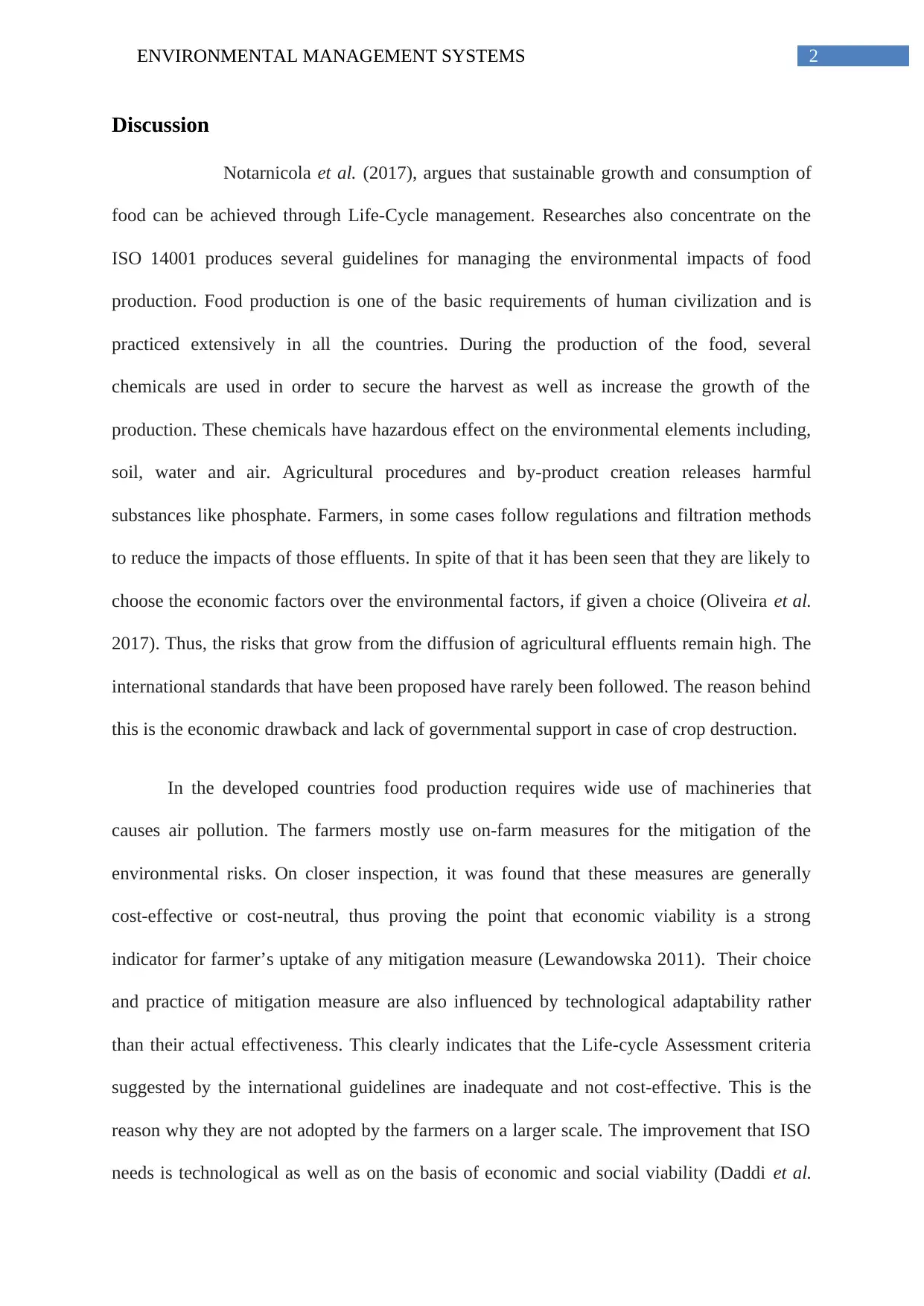
2ENVIRONMENTAL MANAGEMENT SYSTEMS
Discussion
Notarnicola et al. (2017), argues that sustainable growth and consumption of
food can be achieved through Life-Cycle management. Researches also concentrate on the
ISO 14001 produces several guidelines for managing the environmental impacts of food
production. Food production is one of the basic requirements of human civilization and is
practiced extensively in all the countries. During the production of the food, several
chemicals are used in order to secure the harvest as well as increase the growth of the
production. These chemicals have hazardous effect on the environmental elements including,
soil, water and air. Agricultural procedures and by-product creation releases harmful
substances like phosphate. Farmers, in some cases follow regulations and filtration methods
to reduce the impacts of those effluents. In spite of that it has been seen that they are likely to
choose the economic factors over the environmental factors, if given a choice (Oliveira et al.
2017). Thus, the risks that grow from the diffusion of agricultural effluents remain high. The
international standards that have been proposed have rarely been followed. The reason behind
this is the economic drawback and lack of governmental support in case of crop destruction.
In the developed countries food production requires wide use of machineries that
causes air pollution. The farmers mostly use on-farm measures for the mitigation of the
environmental risks. On closer inspection, it was found that these measures are generally
cost-effective or cost-neutral, thus proving the point that economic viability is a strong
indicator for farmer’s uptake of any mitigation measure (Lewandowska 2011). Their choice
and practice of mitigation measure are also influenced by technological adaptability rather
than their actual effectiveness. This clearly indicates that the Life-cycle Assessment criteria
suggested by the international guidelines are inadequate and not cost-effective. This is the
reason why they are not adopted by the farmers on a larger scale. The improvement that ISO
needs is technological as well as on the basis of economic and social viability (Daddi et al.
Discussion
Notarnicola et al. (2017), argues that sustainable growth and consumption of
food can be achieved through Life-Cycle management. Researches also concentrate on the
ISO 14001 produces several guidelines for managing the environmental impacts of food
production. Food production is one of the basic requirements of human civilization and is
practiced extensively in all the countries. During the production of the food, several
chemicals are used in order to secure the harvest as well as increase the growth of the
production. These chemicals have hazardous effect on the environmental elements including,
soil, water and air. Agricultural procedures and by-product creation releases harmful
substances like phosphate. Farmers, in some cases follow regulations and filtration methods
to reduce the impacts of those effluents. In spite of that it has been seen that they are likely to
choose the economic factors over the environmental factors, if given a choice (Oliveira et al.
2017). Thus, the risks that grow from the diffusion of agricultural effluents remain high. The
international standards that have been proposed have rarely been followed. The reason behind
this is the economic drawback and lack of governmental support in case of crop destruction.
In the developed countries food production requires wide use of machineries that
causes air pollution. The farmers mostly use on-farm measures for the mitigation of the
environmental risks. On closer inspection, it was found that these measures are generally
cost-effective or cost-neutral, thus proving the point that economic viability is a strong
indicator for farmer’s uptake of any mitigation measure (Lewandowska 2011). Their choice
and practice of mitigation measure are also influenced by technological adaptability rather
than their actual effectiveness. This clearly indicates that the Life-cycle Assessment criteria
suggested by the international guidelines are inadequate and not cost-effective. This is the
reason why they are not adopted by the farmers on a larger scale. The improvement that ISO
needs is technological as well as on the basis of economic and social viability (Daddi et al.
⊘ This is a preview!⊘
Do you want full access?
Subscribe today to unlock all pages.

Trusted by 1+ million students worldwide
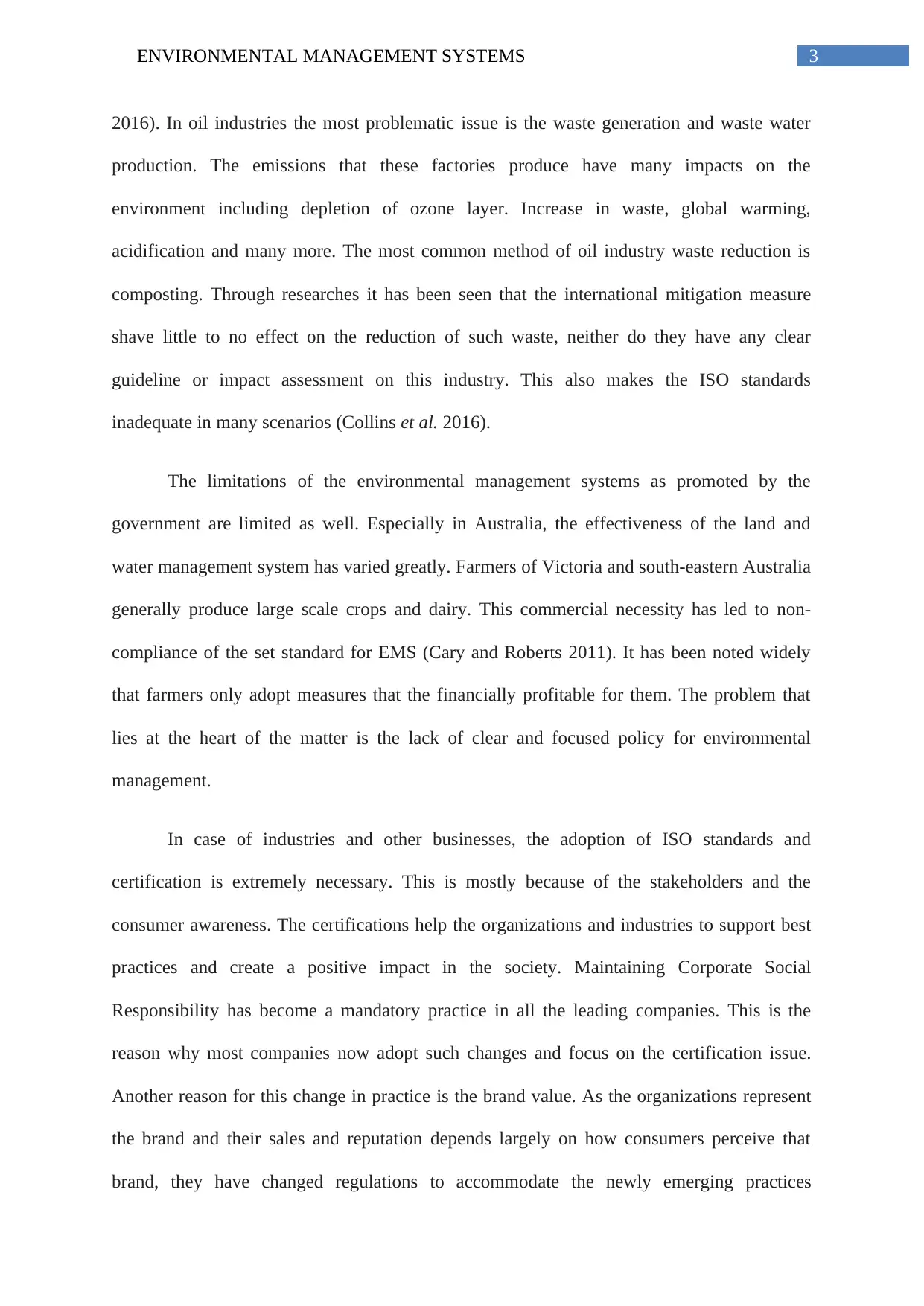
3ENVIRONMENTAL MANAGEMENT SYSTEMS
2016). In oil industries the most problematic issue is the waste generation and waste water
production. The emissions that these factories produce have many impacts on the
environment including depletion of ozone layer. Increase in waste, global warming,
acidification and many more. The most common method of oil industry waste reduction is
composting. Through researches it has been seen that the international mitigation measure
shave little to no effect on the reduction of such waste, neither do they have any clear
guideline or impact assessment on this industry. This also makes the ISO standards
inadequate in many scenarios (Collins et al. 2016).
The limitations of the environmental management systems as promoted by the
government are limited as well. Especially in Australia, the effectiveness of the land and
water management system has varied greatly. Farmers of Victoria and south-eastern Australia
generally produce large scale crops and dairy. This commercial necessity has led to non-
compliance of the set standard for EMS (Cary and Roberts 2011). It has been noted widely
that farmers only adopt measures that the financially profitable for them. The problem that
lies at the heart of the matter is the lack of clear and focused policy for environmental
management.
In case of industries and other businesses, the adoption of ISO standards and
certification is extremely necessary. This is mostly because of the stakeholders and the
consumer awareness. The certifications help the organizations and industries to support best
practices and create a positive impact in the society. Maintaining Corporate Social
Responsibility has become a mandatory practice in all the leading companies. This is the
reason why most companies now adopt such changes and focus on the certification issue.
Another reason for this change in practice is the brand value. As the organizations represent
the brand and their sales and reputation depends largely on how consumers perceive that
brand, they have changed regulations to accommodate the newly emerging practices
2016). In oil industries the most problematic issue is the waste generation and waste water
production. The emissions that these factories produce have many impacts on the
environment including depletion of ozone layer. Increase in waste, global warming,
acidification and many more. The most common method of oil industry waste reduction is
composting. Through researches it has been seen that the international mitigation measure
shave little to no effect on the reduction of such waste, neither do they have any clear
guideline or impact assessment on this industry. This also makes the ISO standards
inadequate in many scenarios (Collins et al. 2016).
The limitations of the environmental management systems as promoted by the
government are limited as well. Especially in Australia, the effectiveness of the land and
water management system has varied greatly. Farmers of Victoria and south-eastern Australia
generally produce large scale crops and dairy. This commercial necessity has led to non-
compliance of the set standard for EMS (Cary and Roberts 2011). It has been noted widely
that farmers only adopt measures that the financially profitable for them. The problem that
lies at the heart of the matter is the lack of clear and focused policy for environmental
management.
In case of industries and other businesses, the adoption of ISO standards and
certification is extremely necessary. This is mostly because of the stakeholders and the
consumer awareness. The certifications help the organizations and industries to support best
practices and create a positive impact in the society. Maintaining Corporate Social
Responsibility has become a mandatory practice in all the leading companies. This is the
reason why most companies now adopt such changes and focus on the certification issue.
Another reason for this change in practice is the brand value. As the organizations represent
the brand and their sales and reputation depends largely on how consumers perceive that
brand, they have changed regulations to accommodate the newly emerging practices
Paraphrase This Document
Need a fresh take? Get an instant paraphrase of this document with our AI Paraphraser
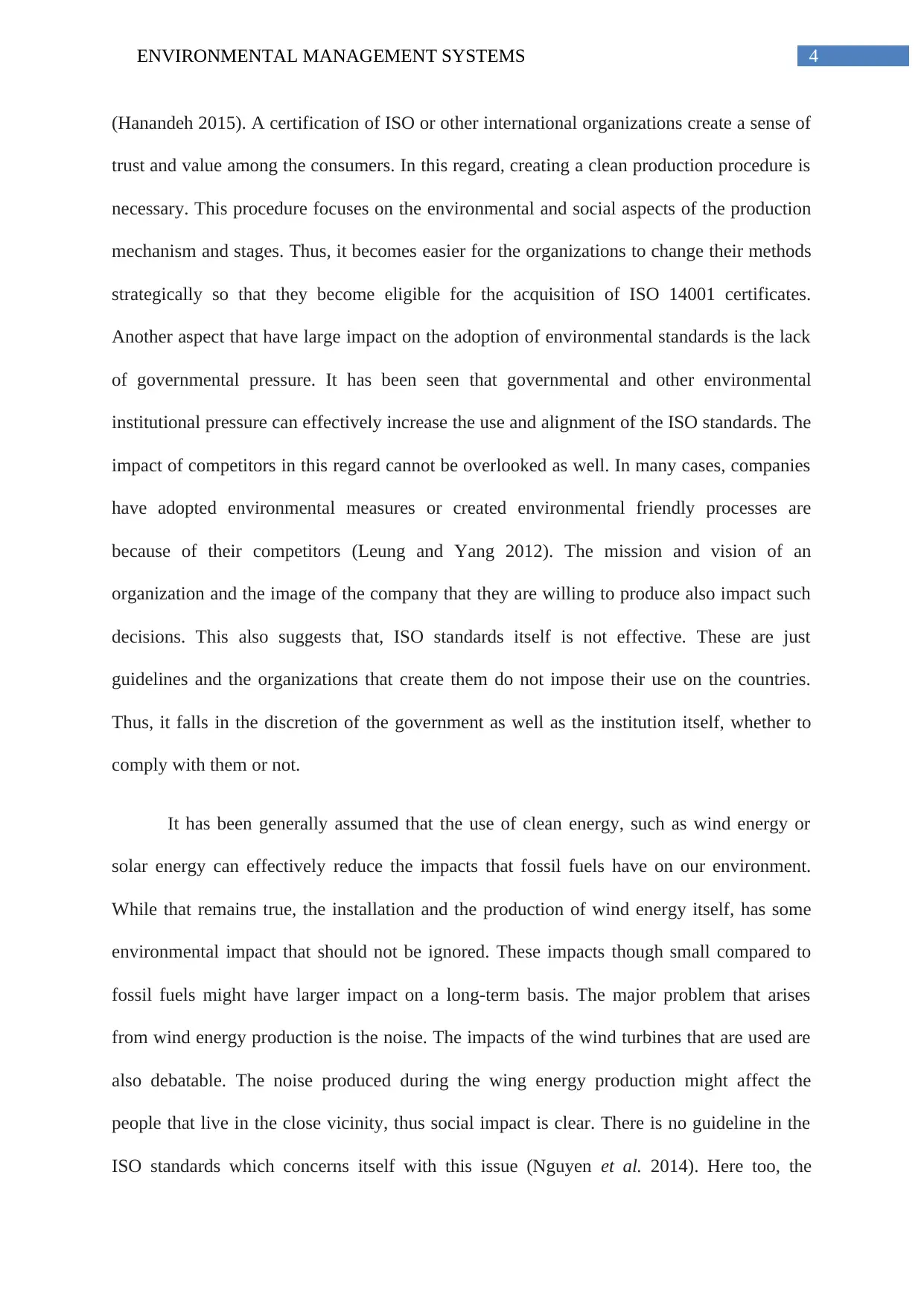
4ENVIRONMENTAL MANAGEMENT SYSTEMS
(Hanandeh 2015). A certification of ISO or other international organizations create a sense of
trust and value among the consumers. In this regard, creating a clean production procedure is
necessary. This procedure focuses on the environmental and social aspects of the production
mechanism and stages. Thus, it becomes easier for the organizations to change their methods
strategically so that they become eligible for the acquisition of ISO 14001 certificates.
Another aspect that have large impact on the adoption of environmental standards is the lack
of governmental pressure. It has been seen that governmental and other environmental
institutional pressure can effectively increase the use and alignment of the ISO standards. The
impact of competitors in this regard cannot be overlooked as well. In many cases, companies
have adopted environmental measures or created environmental friendly processes are
because of their competitors (Leung and Yang 2012). The mission and vision of an
organization and the image of the company that they are willing to produce also impact such
decisions. This also suggests that, ISO standards itself is not effective. These are just
guidelines and the organizations that create them do not impose their use on the countries.
Thus, it falls in the discretion of the government as well as the institution itself, whether to
comply with them or not.
It has been generally assumed that the use of clean energy, such as wind energy or
solar energy can effectively reduce the impacts that fossil fuels have on our environment.
While that remains true, the installation and the production of wind energy itself, has some
environmental impact that should not be ignored. These impacts though small compared to
fossil fuels might have larger impact on a long-term basis. The major problem that arises
from wind energy production is the noise. The impacts of the wind turbines that are used are
also debatable. The noise produced during the wing energy production might affect the
people that live in the close vicinity, thus social impact is clear. There is no guideline in the
ISO standards which concerns itself with this issue (Nguyen et al. 2014). Here too, the
(Hanandeh 2015). A certification of ISO or other international organizations create a sense of
trust and value among the consumers. In this regard, creating a clean production procedure is
necessary. This procedure focuses on the environmental and social aspects of the production
mechanism and stages. Thus, it becomes easier for the organizations to change their methods
strategically so that they become eligible for the acquisition of ISO 14001 certificates.
Another aspect that have large impact on the adoption of environmental standards is the lack
of governmental pressure. It has been seen that governmental and other environmental
institutional pressure can effectively increase the use and alignment of the ISO standards. The
impact of competitors in this regard cannot be overlooked as well. In many cases, companies
have adopted environmental measures or created environmental friendly processes are
because of their competitors (Leung and Yang 2012). The mission and vision of an
organization and the image of the company that they are willing to produce also impact such
decisions. This also suggests that, ISO standards itself is not effective. These are just
guidelines and the organizations that create them do not impose their use on the countries.
Thus, it falls in the discretion of the government as well as the institution itself, whether to
comply with them or not.
It has been generally assumed that the use of clean energy, such as wind energy or
solar energy can effectively reduce the impacts that fossil fuels have on our environment.
While that remains true, the installation and the production of wind energy itself, has some
environmental impact that should not be ignored. These impacts though small compared to
fossil fuels might have larger impact on a long-term basis. The major problem that arises
from wind energy production is the noise. The impacts of the wind turbines that are used are
also debatable. The noise produced during the wing energy production might affect the
people that live in the close vicinity, thus social impact is clear. There is no guideline in the
ISO standards which concerns itself with this issue (Nguyen et al. 2014). Here too, the
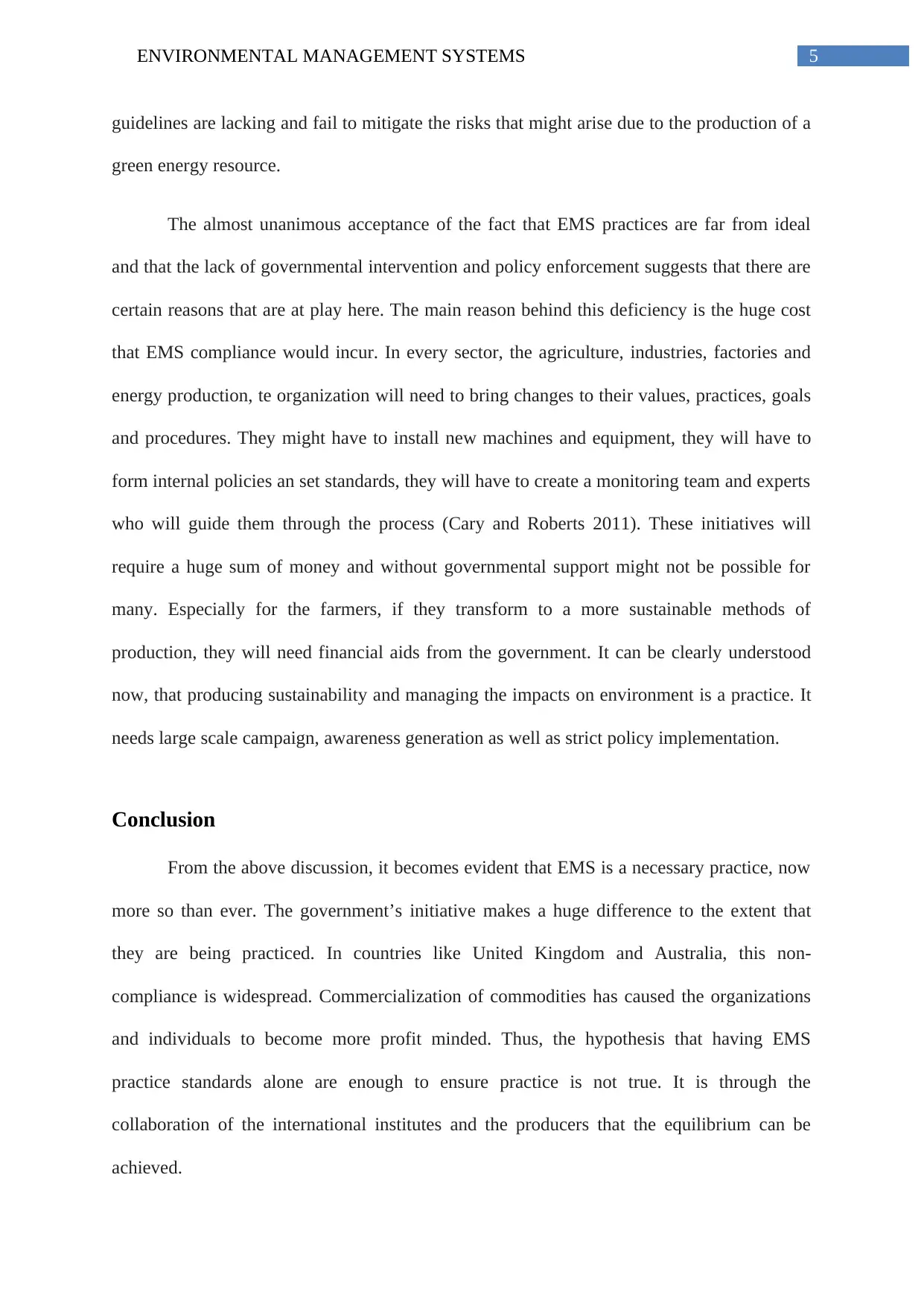
5ENVIRONMENTAL MANAGEMENT SYSTEMS
guidelines are lacking and fail to mitigate the risks that might arise due to the production of a
green energy resource.
The almost unanimous acceptance of the fact that EMS practices are far from ideal
and that the lack of governmental intervention and policy enforcement suggests that there are
certain reasons that are at play here. The main reason behind this deficiency is the huge cost
that EMS compliance would incur. In every sector, the agriculture, industries, factories and
energy production, te organization will need to bring changes to their values, practices, goals
and procedures. They might have to install new machines and equipment, they will have to
form internal policies an set standards, they will have to create a monitoring team and experts
who will guide them through the process (Cary and Roberts 2011). These initiatives will
require a huge sum of money and without governmental support might not be possible for
many. Especially for the farmers, if they transform to a more sustainable methods of
production, they will need financial aids from the government. It can be clearly understood
now, that producing sustainability and managing the impacts on environment is a practice. It
needs large scale campaign, awareness generation as well as strict policy implementation.
Conclusion
From the above discussion, it becomes evident that EMS is a necessary practice, now
more so than ever. The government’s initiative makes a huge difference to the extent that
they are being practiced. In countries like United Kingdom and Australia, this non-
compliance is widespread. Commercialization of commodities has caused the organizations
and individuals to become more profit minded. Thus, the hypothesis that having EMS
practice standards alone are enough to ensure practice is not true. It is through the
collaboration of the international institutes and the producers that the equilibrium can be
achieved.
guidelines are lacking and fail to mitigate the risks that might arise due to the production of a
green energy resource.
The almost unanimous acceptance of the fact that EMS practices are far from ideal
and that the lack of governmental intervention and policy enforcement suggests that there are
certain reasons that are at play here. The main reason behind this deficiency is the huge cost
that EMS compliance would incur. In every sector, the agriculture, industries, factories and
energy production, te organization will need to bring changes to their values, practices, goals
and procedures. They might have to install new machines and equipment, they will have to
form internal policies an set standards, they will have to create a monitoring team and experts
who will guide them through the process (Cary and Roberts 2011). These initiatives will
require a huge sum of money and without governmental support might not be possible for
many. Especially for the farmers, if they transform to a more sustainable methods of
production, they will need financial aids from the government. It can be clearly understood
now, that producing sustainability and managing the impacts on environment is a practice. It
needs large scale campaign, awareness generation as well as strict policy implementation.
Conclusion
From the above discussion, it becomes evident that EMS is a necessary practice, now
more so than ever. The government’s initiative makes a huge difference to the extent that
they are being practiced. In countries like United Kingdom and Australia, this non-
compliance is widespread. Commercialization of commodities has caused the organizations
and individuals to become more profit minded. Thus, the hypothesis that having EMS
practice standards alone are enough to ensure practice is not true. It is through the
collaboration of the international institutes and the producers that the equilibrium can be
achieved.
⊘ This is a preview!⊘
Do you want full access?
Subscribe today to unlock all pages.

Trusted by 1+ million students worldwide
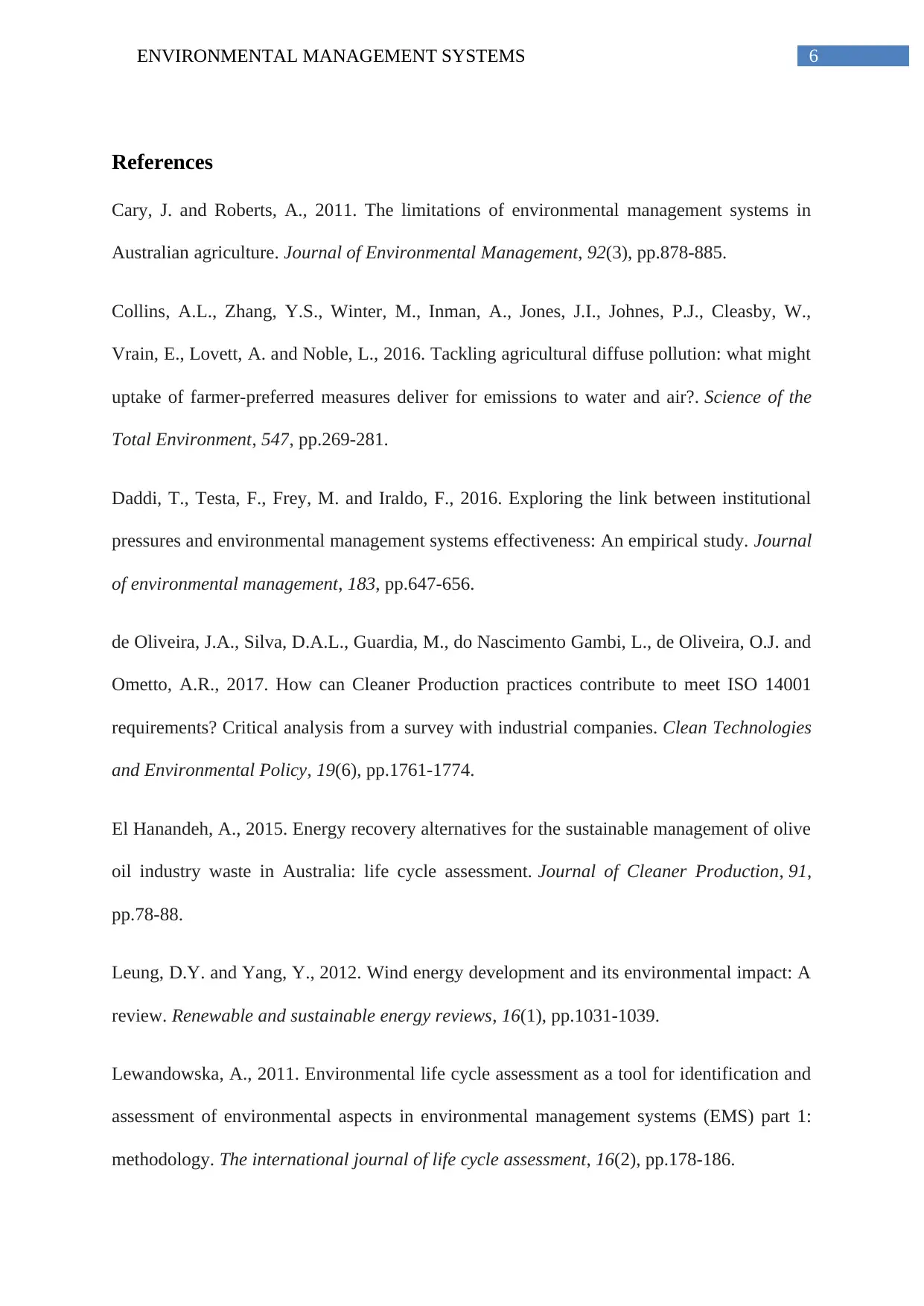
6ENVIRONMENTAL MANAGEMENT SYSTEMS
References
Cary, J. and Roberts, A., 2011. The limitations of environmental management systems in
Australian agriculture. Journal of Environmental Management, 92(3), pp.878-885.
Collins, A.L., Zhang, Y.S., Winter, M., Inman, A., Jones, J.I., Johnes, P.J., Cleasby, W.,
Vrain, E., Lovett, A. and Noble, L., 2016. Tackling agricultural diffuse pollution: what might
uptake of farmer-preferred measures deliver for emissions to water and air?. Science of the
Total Environment, 547, pp.269-281.
Daddi, T., Testa, F., Frey, M. and Iraldo, F., 2016. Exploring the link between institutional
pressures and environmental management systems effectiveness: An empirical study. Journal
of environmental management, 183, pp.647-656.
de Oliveira, J.A., Silva, D.A.L., Guardia, M., do Nascimento Gambi, L., de Oliveira, O.J. and
Ometto, A.R., 2017. How can Cleaner Production practices contribute to meet ISO 14001
requirements? Critical analysis from a survey with industrial companies. Clean Technologies
and Environmental Policy, 19(6), pp.1761-1774.
El Hanandeh, A., 2015. Energy recovery alternatives for the sustainable management of olive
oil industry waste in Australia: life cycle assessment. Journal of Cleaner Production, 91,
pp.78-88.
Leung, D.Y. and Yang, Y., 2012. Wind energy development and its environmental impact: A
review. Renewable and sustainable energy reviews, 16(1), pp.1031-1039.
Lewandowska, A., 2011. Environmental life cycle assessment as a tool for identification and
assessment of environmental aspects in environmental management systems (EMS) part 1:
methodology. The international journal of life cycle assessment, 16(2), pp.178-186.
References
Cary, J. and Roberts, A., 2011. The limitations of environmental management systems in
Australian agriculture. Journal of Environmental Management, 92(3), pp.878-885.
Collins, A.L., Zhang, Y.S., Winter, M., Inman, A., Jones, J.I., Johnes, P.J., Cleasby, W.,
Vrain, E., Lovett, A. and Noble, L., 2016. Tackling agricultural diffuse pollution: what might
uptake of farmer-preferred measures deliver for emissions to water and air?. Science of the
Total Environment, 547, pp.269-281.
Daddi, T., Testa, F., Frey, M. and Iraldo, F., 2016. Exploring the link between institutional
pressures and environmental management systems effectiveness: An empirical study. Journal
of environmental management, 183, pp.647-656.
de Oliveira, J.A., Silva, D.A.L., Guardia, M., do Nascimento Gambi, L., de Oliveira, O.J. and
Ometto, A.R., 2017. How can Cleaner Production practices contribute to meet ISO 14001
requirements? Critical analysis from a survey with industrial companies. Clean Technologies
and Environmental Policy, 19(6), pp.1761-1774.
El Hanandeh, A., 2015. Energy recovery alternatives for the sustainable management of olive
oil industry waste in Australia: life cycle assessment. Journal of Cleaner Production, 91,
pp.78-88.
Leung, D.Y. and Yang, Y., 2012. Wind energy development and its environmental impact: A
review. Renewable and sustainable energy reviews, 16(1), pp.1031-1039.
Lewandowska, A., 2011. Environmental life cycle assessment as a tool for identification and
assessment of environmental aspects in environmental management systems (EMS) part 1:
methodology. The international journal of life cycle assessment, 16(2), pp.178-186.
Paraphrase This Document
Need a fresh take? Get an instant paraphrase of this document with our AI Paraphraser
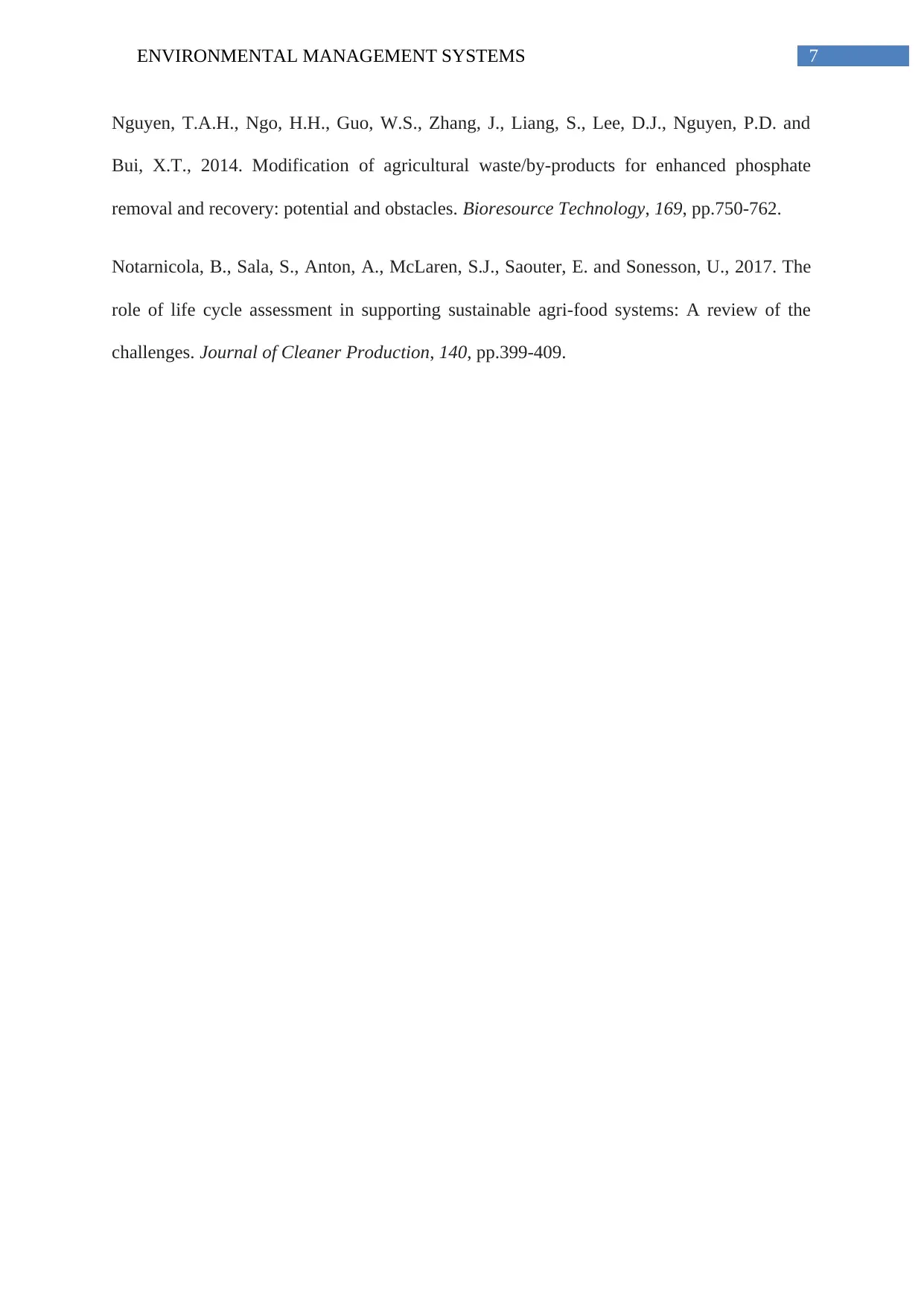
7ENVIRONMENTAL MANAGEMENT SYSTEMS
Nguyen, T.A.H., Ngo, H.H., Guo, W.S., Zhang, J., Liang, S., Lee, D.J., Nguyen, P.D. and
Bui, X.T., 2014. Modification of agricultural waste/by-products for enhanced phosphate
removal and recovery: potential and obstacles. Bioresource Technology, 169, pp.750-762.
Notarnicola, B., Sala, S., Anton, A., McLaren, S.J., Saouter, E. and Sonesson, U., 2017. The
role of life cycle assessment in supporting sustainable agri-food systems: A review of the
challenges. Journal of Cleaner Production, 140, pp.399-409.
Nguyen, T.A.H., Ngo, H.H., Guo, W.S., Zhang, J., Liang, S., Lee, D.J., Nguyen, P.D. and
Bui, X.T., 2014. Modification of agricultural waste/by-products for enhanced phosphate
removal and recovery: potential and obstacles. Bioresource Technology, 169, pp.750-762.
Notarnicola, B., Sala, S., Anton, A., McLaren, S.J., Saouter, E. and Sonesson, U., 2017. The
role of life cycle assessment in supporting sustainable agri-food systems: A review of the
challenges. Journal of Cleaner Production, 140, pp.399-409.
1 out of 8
Related Documents
Your All-in-One AI-Powered Toolkit for Academic Success.
+13062052269
info@desklib.com
Available 24*7 on WhatsApp / Email
![[object Object]](/_next/static/media/star-bottom.7253800d.svg)
Unlock your academic potential
Copyright © 2020–2025 A2Z Services. All Rights Reserved. Developed and managed by ZUCOL.




